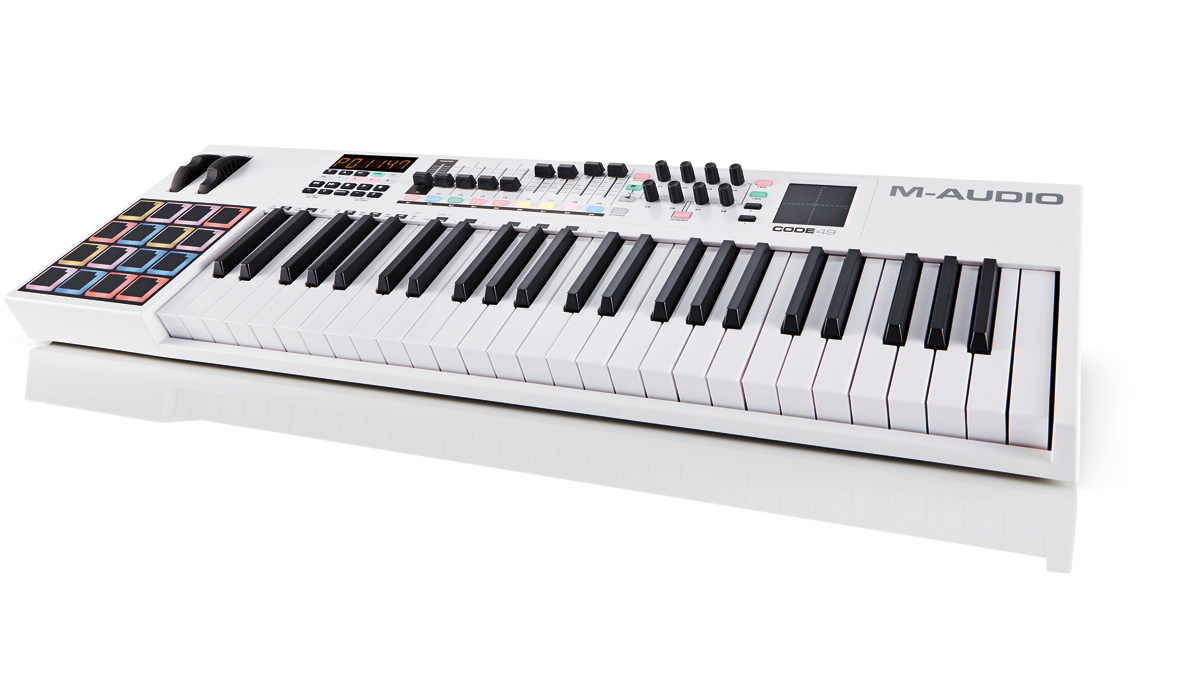MusicRadar Verdict
A welcome addition to M-Audio's catalogue.
Pros
- +
Revised keyboard works well.
Cons
- -
Takes some time to get to grips with.
MusicRadar's got your back
As part of M-Audio's Code range, the 49-Key Controller falls between the series' 25 and 61-key versions.
This new model is buss-powered, using USB as its communication protocol, though it offers traditional MIDI In and Out ports as well.
To the left of the keyboard, you'll find a four-by-four pad array, with all 16 pads offering velocity sensitivity. The middle panel of the main surface offers a slider bank with illuminated buttons below, while the screen to the left offers yet more light and colour. The effect is reminiscent of other keyboard controllers including Native Instruments' light-tastic Komplete Kontrol S-Series range.
Special mention must go to the keyboard itself, which has been revised to produce a more 'playable' action. It certainly offers a much more expressive and responsive feel to that of my original Axiom Pro and, as it provides aftertouch as well as velocity sensitivity, it's a powerful control surface in its own right.
The keyboard can be split into four independent zones, which is great if you want to access multiple plug-ins at once. Of course, with allof this potential, the burning question will be how well these options translate into practice. Is the Code series so bogged down in possibility that its learning curve is too steep to inspire creativity?
Code red, Code green
Well, there is certainly sufficient depth here to make reading the quick-start guide (and downloading the more extensive user guide) essential. To understand why, let's take the pads as an example section of the depth of capability Code provides.
By default, the pads will trigger MIDI notes upwards from C1, with the pads illuminated in different backlit colours changing again when pressed into action. To edit and assign a pad to a different note target, you need to press Edit, then press one of the pads, then a Ctrl Assign key (the keyboard's C1 key), then the Data 1 Key (F#1) and then use the Up/Down keys to move the note assignment to the key of your choice.
A similarly long chain of button presses is required if you're reassigning pads to become MIDI Control triggers instead and, while these chains do become more familiar over time, they don't start out that way. That said, with plenty of presets onboard, the Code keyboards do make life very easy for those looking to have 'expected' controller needs covered, with sensible and helpful assignments offered by default.
Indeed, as well as allowing you to work with 'regular' MIDI assignments within each controller section, the Code keyboards also provide HUI mode, if your DAW supports that protocol. If so, the impressive light show, which glows at the heart of each section, switches to green to illuminate your choice of mode change.
This is reflected from one section to the next, with the Fader and Encoder banks featuring dedicated buttons to allow you to slip from 'onboard' controller assignments to HUI-based ones. You'll soon associate the colours with their modes, making this part of the Code's operation pleasingly slick.
From X to Y
Perhaps the standout control feature offered on the surface of all three Code models, however, is the inclusion of an X-Y pad. As with the Code's other control options, this is fully configurable so that your chosen parameters can be paired to the X and Y axes. There are further options too; the adjacent X and Y buttons instantly send the maximum value for the mapped control number, to facilitate parameter resets or creatively dramatic 'jumps', while there are separate colour-defined modes for the X-Y pad too.
In Red mode, you're working with MIDI Controller assignments, while in Pink mode, you can use the pad to generate notes. Lastly, when in Yellow mode, you can use the X-Y pad as a mouse track-pad for your computer.
The four-octave Code 49, despite its shorter keyboard, packs an otherwise identical feature-set into its frame to that of the Code 61.
“I used everything I knew about music”: How Green Day exceeded expectations with their most ambitious song
YouTube just added AI tools that makes musicians, library music and video editors redundant
“Every one of them said yes without hesitation": Hank Marvin and Roger Taylor have just remade a '60s classic for charity










